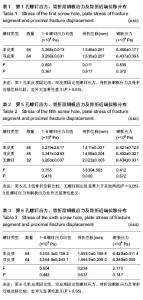| [1] 张英泽.临床创伤骨科流行病学[M]. 北京:人民卫生出版社,2009: 150-204.
[2] Weight M, Collinge C. Early results of the less invasive stabilization system for mechanically unstable fractures of the distal femur (AO/OTA types A2, A3, C2, and C3). J Orthop Trauma. 2004;18(8):503-508.
[3] Button G, Wolinsky P, Hak D. Failure of less invasive stabilization system plates in the distal femur: a report of four cases. J Orthop Trauma. 200418(8):565-570.
[4] 袁天祥,马宝通,赵宝成,等.股骨远端、胫骨近端骨折LISS手术相关因素分析[J].中华骨科杂志,2006,26(4):243-246.
[5] 严力军,廉凯. 股骨远端骨折锁定钢板内固定失败原因分析[J]. 临床急诊杂志,2012,13(2):122-124.
[6] 何锦泉,庞贵根,马宝通,等.微创内固定系统治疗膝关节周围骨折的并发症[J].中国矫形外科杂志,2010,18(2):102-105.
[7] 张岩,杨铁毅,刘树义,等. 有限元分析LISS-DF治疗股骨远端骨折近端螺钉单双皮质不同组合固定方式的应力分布[J]. 中国组织工程研究,2012,16(4):581-584.
[8] 季海龙,张岩,杨铁毅. LISS-DF近端螺钉不同固定方式的有限元分析[J].生物医学工程学进展,2010,31(1):18-22.
[9] 苏再发,贾连顺,张美超,等.颈椎椎体次全切除与钛网植骨钢板固定三维有限元模型的建立[J].医用生物力学,2009, 24(3): 183-188.
[10] 王志钢,杨阳,马信龙,等.个体化股骨模型的建立[J].中国组织工程研究与临床康复,2010,14(4):589-593.
[11] 胡辉莹,何忠杰,吕丽萍,等.应用Mimics软件辅助重建人体胸廓三维有限元模型的研究[J].解放军医学杂志,2008,33(3):273-275.
[12] 许光耀,牛志强,翟丽英,等. 术前MIMICS三维CT重建在股骨髁部粉碎性骨折治疗中的应用[J].中国骨与关节损伤杂志, 2011, 26(12):1104-1105.
[13] 李孝林,任伯绪,徐自胜.兔胫骨骨折的有限元模型[J].中国组织工程研究,2013,17(4):620-624.
[14] 尤微,王大平,刘国平,等.数字骨科三维可视化技术在肱骨近端粉碎性骨折术前规划中的应用[J].中国现代手术学杂志,2013, 17(1): 25-29.
[15] 陈羽,宋烜,张海兵.三维重建及虚拟手术在复杂胫骨平台骨折治疗中的应用[J].中国组织工程研究,2013,17(39):6940-6945.
[16] 徐洪璋,余斌.髌骨骨折AO张力带内固定有限元模型的建立和分析[J].中国组织工程研究与临床康复,2011,15(13):2339-2344.
[17] 李雷,陈福状,姜红堃,等.枢椎有限元模型的建立及齿状突骨折的三维有限元分析[J].中国医科大学学报,2013,42(3):277-280.
[18] 李维新,袁斌云.跟骨骨折锁定钢板内固定与普通钢板内固定的有限元分析[J].中医正骨,2013,25(4):10-11.
[19] 刘福,吴树建,王立强. 新型医用钛合金的特点及发展现状[J].热加工工艺,2008,37(12):100-103.
[20] 张弢,张清功,马信龙,等.应用CT断层图像重建股骨有限元模型[J].生物医学工程与临床,2008,12(6):446-450.
[21] 杨永良,周东,张庆斌,等.四种内固定方式治疗股骨远端骨折的疗效比较[J].中华创伤骨科杂志,2012,14(11):954-958.
[22] 罗从风,姜锐,胡承,等.微创固定系统治疗膝关节周围复杂骨折[J].中华骨科杂志,2006,26(7):454-458.
[23] 马伟,彭新,朱磊,等. LISS钢板治疗老年股骨远端骨折[J].江苏医药,2011,37(9):1090-1091.
[24] 李逸群,包杭生,吴峰,等.锁定加压钢板治疗C型股骨远端骨折19例临床报告[J].中国中医骨伤科杂志,2011,19(4):17-18.
[25] 廖春来,王培信,李培浩,等.股骨远端复杂骨折的内固定方式选择[J].中国矫形外科杂志,2011,19(8):624-627.
[26] 张韶民,王明君,苗卫东,等.股骨远端锁定钛板内固定治疗股骨髁间骨折[J].中医正骨,2011,23(6):46-47.
[27] 林振恩,魏艳珍.新型蝶形锁定加压钢板治疗AO-C型桡骨远端骨折的疗效分析[J].中华关节外科杂志(电子版),2011,5(4): 513-517.
[28] 林振恩,林焱斌. PFNA、Gamma钉和DHS治疗股骨粗隆间骨折疗效比较[J].山东医药,2008,48(27):109-110.
[29] Smith TO, Hedges C, MacNair R, et al. The clinical andradiological outcomes of the LISS plate for distal femoral fractures: asystematic review. Injury. 2009;40(10):1049-1063.
[30] Zlowodzki M, Bhandari M, Marek DJ, et al. Operative treatment of acute distal femur fractures: systematic review of 2 comparative studies and 45 case series (1989 to 2005). J Orthop Trauma. 2006;20(5):366-371.
[31] 王光林,张晖,刘雷,等.膝关节周围骨折的治疗建议[J].中华创伤骨科杂志,2010,12(12):1150-1155.
[32] 王竞超,罗从风.膝关节周围骨折诊治进展[J].国际骨科学杂志, 2012, 33(4):258-260.
[33] 张魁忠,吴柄华,徐聪,等.螺钉数量对钢板螺钉内固定结构载荷的生物力学影响[J].中国组织工程研究与临床康复,2009,13(43): 8454-8457.
[34] Yin B, Chen W, Zhang Q, et al. Tibial fracture treatedby minimally invasive plating using a novel low-cost, high-technique system. Int Orthop. 2012;36(8):1687-1693.
[35] 潘垚.四肢骨质疏松性骨折的治疗[J]. 国际骨科学杂志,2009, 30(6):400-401.
[36] Niemeyer P, Südkamp NP. Principles and clinical application of the locking compression plate (LCP). Acta Chir Orthop Traumatol Cech. 2006;73(4):221-228.
[37] 张培训,武京伟,王静,等.股骨远端骨折手术治疗的多中心回顾性研究[J].中华创伤骨科杂志,2011,13(4):336-340.
[38] 冯大倡,雷春,陈森荣.锁定钢板治疗股骨骨折内固定术后松动、骨折不愈合的疗效分析[J].当代医学,2012,18(18):88-89.
[39] 徐文华,袁晓军,舒敏锐,等. 探讨长骨骨干骨折内固定术后断裂及松动的原因[J].中国实用医药,2012,7(31):36-37.
[40] 张功林,葛宝丰.锁定钢板国外应用进展[J].中国骨伤,2009,23(8): 643-645. |

